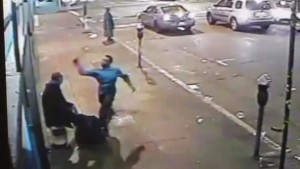Sara Conklin, Washington, DC, USA, SSH Blog Correspondent

If I asked you to imagine in your head a scenario involving street harassment and a homeless person, what would you picture? If the hour I just spent scrolling through Google is any indication, you’re imagining an unassuming individual being harassed by a surly person who looks to be sleeping on a street corner. This happens, A LOT. I’ve been harassed by a seemingly unhoused individual on many occasions and as someone who works in the field of homelessness in Washington, DC, I am intimately familiar with the myriad of reasons a homeless person can “act out of order,” related to a series or traumas or serious mental illnesses/addiction stemming from chronic homelessness.
But that’s not what I want to talk about —
Far fewer people are flipping the script on the conversation of harassment and homeless people, choosing also to discuss how people experiencing homelessness are often cruelly harassed themselves.
Try to imagine instead, a homeless person who has struggled with serious depression and mental illness and asks for money on the street in an unthreatening and polite manner. Instead of a humble, “no” the solicited person replies with a vulgar and dehumanizing response. This happens more often that you’d think. I’d recommend watching this heartbreaking video, to give you a good picture of such cruelty (and these were just online tweets; the harassment in person can be much worse). One person even asks, “If home is where the heart is, do homeless people even have hearts?”
I come from an organization that supports 60% of the homeless women in our metropolitan area. Our working mantra is that, “But for a few circumstances of fortune and timing, ‘she’ could be me.” The women I have met here are survivors. They have faced unparalleled odds against them and come out on the other side. If we are discussing “street harassment” as unwanted comments, gestures, and actions forced on a stranger, particularly with an actual or perceived gender-bias, homeless women might take the cake.
I have no intention of ignoring the legitimate case that homeless men are antagonized and harassed every day, but I’ve learned firsthand from clients that identify as female, that unaccompanied homeless women disproportionately face, “multiple forms of interpersonal victimization, including sexual and physical assault at the hands of strangers, acquaintances, pimps, sex traffickers, and intimate partners on the street, in shelters, or in precarious housing situations (vawnet.org).”
In the United States we have already made public spaces unsafe for people experiencing homelessness. Reference for example, how it has been outlawed to sit down in San Francisco, or the effort to make it illegal to give people food in Philadelphia, how Manteca purposely changed the water sprinkler schedule to keep the homeless from sleeping in a park, or how Sarasota just got rid of their park benches altogether.
These degrading and brutalizing efforts coupled with verbal attacks from housed city residents can make the day-to-day life of a homeless person unbearable.
But the bigger conversation centers on how we’ve come to tolerate the harassment of a homeless person more than that of a seemingly housed person. It very well could be that the vast majority of readers are appalled by this and reject entirely the thought. But that doesn’t mean it isn’t happening.
The sad truth is, the majority of Americans treat homeless people like occupied public spaces. In other words, without context, making assumptions about why that person is there and why they can or cannot leave. Those are not our assumptions to make. But once we do, it makes it easier for us to dehumanize a person enough to permit their mistreatment.
Since many of us treat our parks and streets with a certain abandon for retribution, we tend to treat the people who occupy those spaces recklessly as well – it’s as if we feel that since the park is public, the person who sleeps there is publicly owned as well, which leaves me entitled to judge them. That sort of entitlement can lead to vocalizing slurs or prejudicial comments without fear of consequence. When a person is on their knees, it’s easier to knock them down.
As we discuss the innumerable ways in which street harassment exists in our everyday lives, and the inconceivable reality that people can be objectified and reduced to targets of harassment merely by existing in a public space, we should acknowledge the ways we treat all individuals who occupy public spaces, including those facing homelessness.
What compels someone to harass a homeless person is a concept I may never understand. But, I can begin to infer that it has something to do with entitlement in communal areas – how we choose when or when not to vocalize observations or opinions about another person sharing a collective space, can speak volumes about our compassion and empathy.
As I continue to demand respect for myself when I occupy a street or sidewalk, I will also petition others to demand the same respect for others regardless of circumstance. After all, “But for a few circumstances of fortune and timing, ‘she’ could be me.”
Sara works in fundraising events at an organization that empowers women who face homelessness through recovery, wellness training, and housing. She runs her own photography company (saraconklinphotography.com) and a popular website that seeks to connect the world through pictures, sarapose.com.
